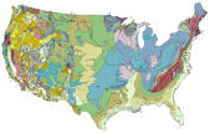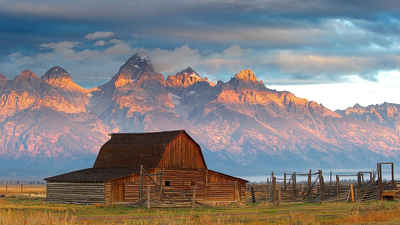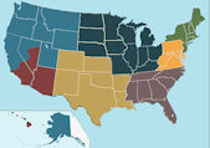Wyoming Geography: The Land
Geography and Landforms of Wyoming
 Find
an overview of Wyoming geography, topography, geographic land regions, land areas, and major rivers.
Find
an overview of Wyoming geography, topography, geographic land regions, land areas, and major rivers.
Access Wyoming almanac furnishing more details on the state geography, geographical and land regions, climate and weather, elevation, land areas, bordering states, and other statistical data.
Wyoming is bordered by Montana on the north and
Utah and Colorado on the south. On the east, Wyoming is bordered by South Dakota and Nebraska. On the west, Wyoming is bordered by Idaho and Utah.
Wyoming is the second "highest" state in the US, having a mean elevation of 6,700, second only to the state of Colorado.
Major rivers in Wyoming include the Bighorn, Green, Belle Fourche, Powder and North Platte River.
Wyoming Highest, Lowest, & Mean Elevations |
|
|---|---|
| Mean Elevation | 6,700 ft. |
| Highest Point | Gannett Peak 13,804 ft. |
| Lowest Point | Belle Fourche River 3,099 ft. |
Wyoming Land Area (Square Miles) |
|
| Geographic Center | In Fremont County, 58 mi. ENE of Lander Longitude: 107° 40.3'W Latitude: 42° 58.3'N |
| Total Area | 97,813.56 sq. mi. 10th |
| Land Area | 97,100.40 sq. mi. 99.20% |
| Water Area | 713.16 sq. mi. 0.80% |
| Forested Land Area | 78.5% |
| Dimensions (Length - Width) |
360 miles - 280 miles |
Wyoming: Physiographic Regions
Wyoming has six physiographic regions:
- the Black Hills;
- the Great Plains;
- the Southern Rocky Mountains,
- Middle Rocky Mountains, and
- Northern Rocky Mountains; and the
- Wyoming Basin.
Black Hills
The Black Hills extend into South Dakota and are of generally low relief.
Great Plains
Wyoming's Great Plains region occupies the easternmost one-third of the state, gradually increasing in elevation from the state's eastern border to the many mountain ranges that mark the region's western margin.
This area is made up of short-grass prairie and with cottonwoods and shrubs growing along the rivers in the area. This area receives little rainfall. Along the border of South Dakota the Black Hills spread into the state. About one third of the Black Hills are located in Wyoming. This area is where the Devils Tower National Monument is located.
The Big Horn mountains front the Great Plains in the north. Fronting the Great Plains in the south is the Laramie Range that extends into Wyoming from Colorado. There is a wide Plateau that lies between these two ranges.
Rocky Mountains ( Southern , Middle and Northern)
A slope, that is a narrow strip of land that rises from the plains to the Laramie Mountains, sometimes called the "Gangplank" that provides a direct route from the Great Plains into the higher mountain areas of the state. The Absaroka Range rises on the Eastern edge of Yellowstone Park. The Wind River Range, in west central Wyoming is some of the most rugged mountain territory in the state. The highest point in Wyoming is Gannett Peak (13,804 feet) is found in this mountain range. South of the Wind River Ranges is the Granite Mountains. The Teton Mountains are over a mile above Jackson Hole Valley. Gros Ventre, Salt River, Snake River, and Wyoming ranges are found along the border. The Medicine Bow and Sierra Madre ranges are located to the south. '
Southern Rocky Mountains
Central Colorado makes up the bulk of the Southern Rockies. The Southern Rocky Mountains extend from northeastern Colorado along the Laramie, Medicine Bow, and Sierra Madre ranges, making their farthest extension into Wyoming along the Laramie Range, where the mountain system terminates just south of the North Platte River near the city of Casper.
'Steep, rugged mountains cover this region, and vegetation varies greatly on the basis of elevation and aspect. Alpine tundra gives way to various coniferous forests often with aspen intermixed. Ponderosa pine is at lower elevations, pinyon-juniper below that, and grasslands in the lowest areas. Because of topography, weather, avalanches, fire, insect outbreaks, and disease, forests in the Southern Rocky Mountains tend to be patchier than in many other areas. The landscape is thus a complex mosaic of open meadows and forest stands of varying age and species composition.
Middle Rocky Mountains
The Middle Rockies is a huge physiographic area, extending from northwest Wyoming over all of western Montana, the northern 2/3 of Idaho, large areas of eastern Oregon and Washington, much of southeast British Columbia and a sliver of west Alberta.
Included in this region are the scenic Bighorn and Wind River mountain ranges, the geysers and fumaroles of Yellowstone Park, the igneous Absaroka Plateau on the park's eastern margins, and Gannett Peak.
It is an area of high mountains, with elevations up to 2,700 m (9,000 ft). Glaciation has left broad flat valleys between mountain ranges. Elevation determines the dominant vegetation. Highest areas are alpine tundra. The subalpine zone is dominated by Engelmann spruce and subalpine fir, with ponderosa pine and Douglas fir in the montane zone below that. Stand-replacement fire can change forests in either of those zones to lodgepole pine or aspen. Grass and sagebrush occur under open pine forests that grade downslope into grasslands, woodlands, or shrubsteppe.
Northern Rocky Mountains
The Northern Rocky Mountain region extends south from Canada across the states of Montana and Idaho and enters Wyoming at the northwestern corner of Yellowstone Park.
Wyoming Basin
As its name suggests, the Wyoming Basin is primarily in Wyoming but also extends into northern Colorado, southern Montana, and very small parts of northeast Utah and southeast Idaho
The Wyoming Basin borders the Continental Divide between the Southern and Middle Rocky Mountains and is composed of interspersed smaller mountains and intermontane basins. This region includes Flaming Gorge, created by the erosive action of the Green River, and the Great Divide Basin, which encloses an area of interior drainage with no outlet
The area consists of broad intermountain basins interrupted by isolated hills and low mountains that merge to the south into a dissected plateau. It is basically a shrubsteppe, dominated by sagebrush and shadscale, interspersed with areas of shortgrass prairie. Higher elevations are in mountain shrub vegetation, with coniferous forest atop the highest areas.
Wyoming Landscape and Landforms:
Central Shortgrass Prairie
The Central Shortgrass Prairie Physiographic Area covers much of eastern Colorado and smaller portions of western Kansas, southwestern Nebraska, and southeastern Wyoming.
The region contains flat to gently rolling topography, with occasional canyons and bluffs. Elevations within Colorado range from about 975 m (3,200
ft) in Prowers County to about 1800 m (6,000 ft.) around Limon and near the foothills of the Rockies. Principal rivers include the South Platte, Arikaree,
Big Sandy, Republican, and Arkansas. Precipitation is low, less than 50 cm (20 in) per year with most of that falling in spring and summer; total precipitation
varies greatly between years at a given location and varies significantly more than in mixed grass or tallgrass systems (Wiens 1972). Mean monthly
temperatures range from -12°C (10°F) in winter to 38°C (100°F) in summer. Localized severe weather is not uncommon, and blizzards,
hailstorms, and tornadoes occur in most years.
The dominant habitat in this physiographic area is shortgrass prairie. Shortgrass is dominated by two low-growing warm-season grasses, blue grama and
buffalo grass; western wheatgrass is also present, along with taller vegetation including widespread prickly-pear cactus and yucca, and cholla in the
south. Sandsage prairie is found where sandy soils occur, and is dominated by sand sagebrush and the grasses sand bluestem and prairie sand-reed. Mixed
grass (needle-and-thread, side-oats grama) and tallgrass (big bluestem, little bluestem, switchgrass) communities occur locally
Northern Shortgrass Prairie
The westernmost and driest part of the North American grasslands, the short grass prairie occupies regions with 10 to 12 inches of precipitation a year. A single herb layer exists and consists primarily of bunch grasses some 12 to 18 inches high. They have relatively shallow root systems. Soils are lighter brown than those under the other two formations and the calcium carbonate layer is closer to the surface. These grasslands are used today as rangeland for cattle. Many parts, including the national grasslands, are severely overgrazed and have been invaded by prickly pear cactus and other thorny plants. Due to excellent game management practices some states with short grass prairie still have large populations of pronghorn. Elk, feral horses, and mule deer also share the range with cattle. Bison still occur but are privately owned or are maintained on special federal reserves.
Utah Mountains
These north-to-south lying mountains are centered in Utah and extend slightly into Wyoming and Idaho. They consist of the Wasatch and Uinta Ranges and separate the Great Basin from the Colorado Plateau. The four primary vegetation types reflect elevation and are similar to those in the Southern Rockies. Alpine tundra tops the highest areas, and a subalpine fir and Englemann spruce zone lies below that. Both the subalpine zone and the next lower zone, a montane area dominated by Douglas fir and ponderosa pine, can be converted by fire into lodgepole pine or aspen stands. Pine in the montane zone is often underlain by sagebrush and grasses. The fourth and lowest zone is a woodland dominated by mountain-mahogany, scrub oak, or pinyon-juniper.
Intermontane Basins
Between Wyoming mountain ranges are flat area that are short grasses and lower brush that are part of the Intermontane Basins. They are mostly treeless and have small amounts of rainfall. The Bighorn and Powder River Basins are major basins in the north. The Wind River Basin in central Wyoming and the Green River, Great Divide, and Washakie Basins are major basins in the south.
The Great Divide Basin runs along the Continental Divide. There is little rainfall in this area. The Red Desert that covers a part of the Great Divide Basin and an area to the south of the basin. Plant life, in this area is very thinly dispersed.






